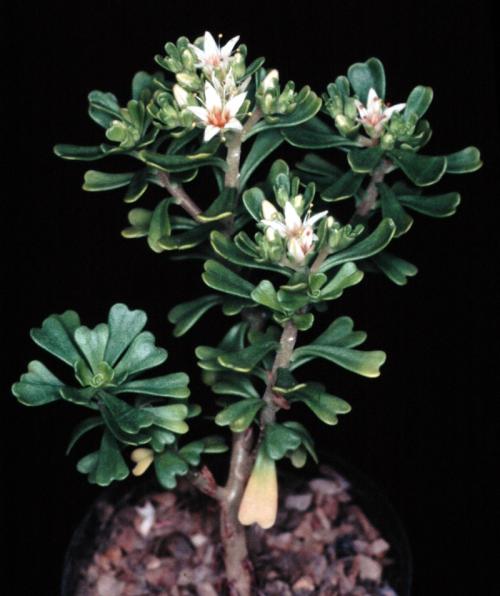RETUSUM Hemsley, 1880
Distribution : Mexico (San Luis Potosí, southern Tamaulipas, Hidalgo), 2000 - 2700 m.
Description (according to IHSP, 2003) :
Perennial subshrubs with short basal stem and several erect tuberculately roughened branches, 30 - 50 cm tall.
Leaves broadly spatulate, usually retuse, pseudo-petiolate, shortly spurred, flat, densely mamillate in the upper part, 10 -17 mm.
Inflorescences : Small broad few-flowered corymbs, bracts leaf-like, oblanceolate, mamillate.
FIowers 5-merous, subsessile, sepals basally free, broadly spurred, unequal, broadly oblanceolate-spatulate, obtuse, thick, densely mamillate, 2,5 - 5 mm, petals free to the base, lanceolate, subobtuse, submucronate, with slightly narrowed base, carinate, white or reddish, 6 - 6,5 mm.
Cytology : 2n = 54, 55, 56 - 62
Ray Stephenson (Sedum, Cultivated Stonecrops, 1994, pp 242 - 243) :
A rare subshrub in cultivation, Sedum retusum attains a height of about 15 cm (6 in), with bare stems below, except for aerial roots. It is topped with glabrous, grooved, spathulate leaves with distinctly retuse apices. Loose rosettes of medium green leaves often flush red in full sun. In many respects, leaves, and flowers with petals which have rose bases, are similar to those of S. oxypetalum, but stems of S. retusum are never massive.
Habitat : This stonecrop is native to San Luis Potosí, southern Tamaulipas, and Hidalgo in the Eastern Sierra Madre.
Main points of distinction : The only other species with such rounded and shallowly notched apices to the leaves is Sedum obcordatum, but S. obcordatum has glaucous, opposite-decussate, and obcordate (heart-shaped) rather than retuse leaves. The inflorescence of S. retusum is usually composed of two short, scorpioid branches, each with a few flowers, produced in summer. Sepals are free, erect, narrowed in the middle, and uneven. Petals are erect in the lower half. n = 27, n = 28 +1, n = 29, and n = 31.
Variation : Despite the variety of chromosome counts, the morphology is fairly constant.
Horticulture : This is a neat plant for pot culture. It is particularly slow ; perhaps development of aerial roots on my plant are an indication I am underwatering, but having had plants rot at the base on several occasions, I tend to water sparingly.
